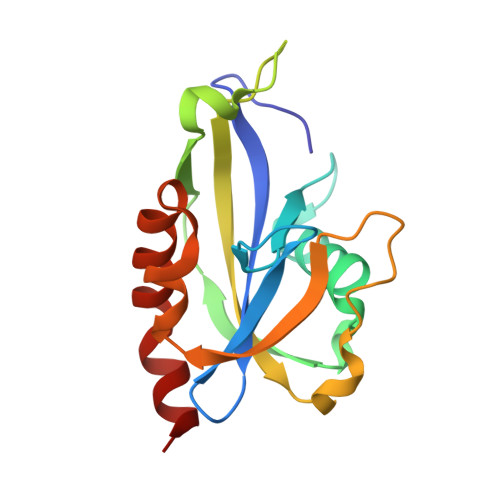Principles of RNA and nucleotide discrimination by the RNA processing enzyme RppH.
Gao, A., Vasilyev, N., Kaushik, A., Duan, W., Serganov, A.(2020) Nucleic Acids Res 48: 3776-3788
- PubMed: 31960065
- DOI: https://doi.org/10.1093/nar/gkaa024
- Primary Citation of Related Structures:
6VCK, 6VCL, 6VCM, 6VCN, 6VCO, 6VCP, 6VCQ, 6VCR - PubMed Abstract:
All enzymes face a challenge of discriminating cognate substrates from similar cellular compounds. Finding a correct substrate is especially difficult for the Escherichia coli Nudix hydrolase RppH, which triggers 5'-end-dependent RNA degradation by removing orthophosphate from the 5'-diphosphorylated transcripts. Here we show that RppH binds and slowly hydrolyzes NTPs, NDPs and (p)ppGpp, which each resemble the 5'-end of RNA. A series of X-ray crystal structures of RppH-nucleotide complexes, trapped in conformations either compatible or incompatible with hydrolysis, explain the low reaction rates of mononucleotides and suggest two distinct mechanisms for their hydrolysis. While RppH adopts the same catalytic arrangement with 5'-diphosphorylated nucleotides as with RNA, the enzyme hydrolyzes 5'-triphosphorylated nucleotides by extending the active site with an additional Mg2+ cation, which coordinates another reactive nucleophile. Although the average intracellular pH minimizes the hydrolysis of nucleotides by slowing their reaction with RppH, they nevertheless compete with RNA for binding and differentially inhibit the reactivity of RppH with triphosphorylated and diphosphorylated RNAs. Thus, E. coli RppH integrates various signals, such as competing non-cognate substrates and a stimulatory protein factor DapF, to achieve the differential degradation of transcripts involved in cellular processes important for the adaptation of bacteria to different growth conditions.
Organizational Affiliation:
Department of Biochemistry and Molecular Pharmacology, New York University School of Medicine, 550 First Avenue, New York, NY 10016, USA.














